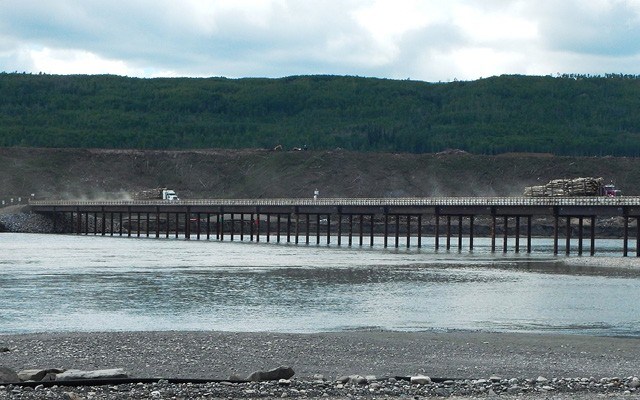Although you'll see the occasional item in mainstream media (usually eschewing bald facts to highlight the scurrilous act of protest itself), silence over the impending travesty of BC Hydro's Site C hydroelectric dam is deafening. This is sad from two standpoints: first, not only is this project grievously wrongheaded, but it will saddle us with higher electric bills in perpetuity; and second, because public laissez-faire over something so far removed from most of our view is exactly what our proponent government, its lapdog utility, and big-oil overlords are counting on. And so the Site C drama amounts to a farce barrelling headlong into tragedy.
To start, the proposed $8.8 billion dam is already estimated to exceed $10 billion. It will flood an 83-kilometre stretch of agriculturally important land in a province that imports 70 per cent of fruits and vegetables — including the largest ever removal from B.C.'s Agricultural Land Reserve. The usual Luddites shout about unsubstantiated jobs and energy security; farmers, First Nations, and conservation groups respectfully point to loss of land and heritage, the trampling of indigenous rights, degradation of fish and wildlife habitat, dubious exemptions from regulations, and, most bafflingly, a demonstrable lack of need. Harry Swain, Associate Fellow at the Centre for Global Studies at the University of Victoria chaired the Canadian and BC Environmental Assessment Agencies' Joint Review Panel (JRP) that approved Site C: "There's no need for Site C. If there was we could meet it with a variety of other renewable and smaller-scale sources. Of the $9 billion it will cost, at least $7 billion will never be returned." Damn.
In a 2015 Supreme Court affidavit, former BC Hydro CEO Marc Eliesen lambasted the utility's absurd claim that a one-year delay in construction would add $420 million to the bill as based on "fundamentally flawed" analysis. Eliesen also stated that proceeding with Site C was "highly imprudent." To wit: American energy economist Robert McCullough calculated that a delay of one-year would save ratepayers $268 million, two-years, $519 million, and five-years, $1.18 billion. Double damn.
Though their numbers don't add up, the province and utility claim Site C is in our best interests. Yet history suggests neither can be trusted to care for interests other than those of the resource-extraction industries keeping them in power (haha) — including IPPs. In 2015, hydro paid $1.23 billion plus delivery costs to private producers; in the same period it exported a similar amount and received only $460 million. Power from IPPs now averages 9.8¢/KWh while unprofitable export markets have returned less than 3.6¢/KWh since 2003. But despite a decrease in consumption by residential, commercial and industrial consumers, hydro increased IPP purchases since 2008, delivering them of $4.6 billion over the period, on track to reach $8.3 billion in the next five years; add in a projected $6 billion write-off for deferred costs and we'll be paying rates 60 per cent higher than the past five years. With $10 billion committed to Site C, $2 billion/yr in other capital expenditures, and absent profitable new markets, electricity prices could easily rise by 100 per cent.
So whither Site C? With plummeting gas prices, Premier Christy Clark's LNG hallucination hasn't materialized to sign up. With cheaper hydro available elsewhere, and the growing shift to wind, solar and geothermal, ecologically destructive megadams like Site C are anachronistic — even being dismantled in the U.S. on the heels of scientific consensus. Yet in Canada, when 250 top scientists pen a letter urging the misguided project be stopped because its significant environmental effects are unprecedented in our history, it is instead fast-tracked by a Premier bent on getting it "past the point of no return." And make no mistake, while we blind-eye sleep in the Lower Mainland, excavators are already digging up the Peace under the guise of a "Clean Energy Act" (candy-coated 2010 legislation that enables the province to bypass normal BC Utilities Commission reviews) while indigenous rights, environmental concerns, and common sense are overlooked. A legal challenge even had to be filed recently to ask for judicial review of the government's actions in granting BC Hydro permission to move amphibians without proper permits issued under the Wildlife Act.
The Peace, of course, already has a damning history of dams — Site A (1968), a.k.a. the WAC Bennett Dam and Site B (1980), the Peace Canyon Dam. Doubtless some see a third dam on the already impacted Peace as better than damming a virgin river elsewhere, but not local indigenous groups who lost much to those dams. The Treaty 8 First Nations is fighting the Site C decision in court, claiming it overrides treaty rights. Indeed the JRP stated as much in saying Site C would have irreversible adverse impact on hunting, fishing, and traditional land use. So by quietly issuing permits for the dam just prior to the August long weekend, Justin Trudeau's Liberal government not only joined Clark's criminal cabal in thumbing its nose at ongoing legal challenges, but broke its much ballyhooed promise of a renewed relationship with Canada's First Nations.
Damn. Damn. Damn.
Leslie Anthony is a Whistler-based author, editor, biologist and bon vivant who has never met a mountain he didn't like.




